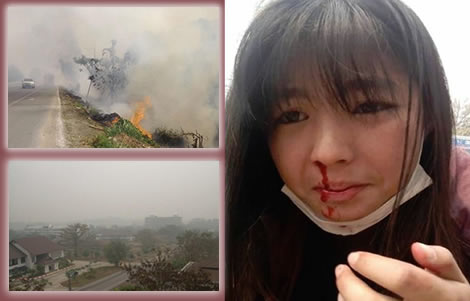The dramatic photo of a young Thai woman bleeding from the nose and mouth was published by a daily newspaper in Thailand this month to illustrate the dangers of air pollution levels over the last month in country’s northern provinces. In the last week, the figures have shown levels of air pollution well over accepted safety thresholds with some areas in the last few days recording staggeringly high readings. In the middle of March, the beautiful city of Chiang Mai had the dubious honor of being identified briefly as the most polluted city on earth. The cause of the problem is Thai farmers burning materials to prepare for new crops and to a lesser extent, drifting smog from neighboring Myanmar. While the Thai government, through its Pollution Control Department, has provided the public with guidance and expert advice to help alleviate the threat, there are also signs that the air pollution may be beginning to impact tourism activity in the area which is renowned for it culture and beauty among international travelers.
Thailand’s northern provinces including Chiang Mai and Chiang Rai continue to experience poor air quality that has been confirmed as damaging to human health. In the last month, the pollution in the area has been confirmed as the worst in the world. The picture of a young Thai woman, some weeks ago, with blood emanating from her nose and mouth highlighted the danger of fine particulate matter in the air or smog to human beings. This week has seen some of the highest readings as the haze continues to hover over 9 northern provinces with the effects extending as far as central Thailand. The problem, amazingly, is not caused by climate change or industrial pollution but by Thai farmers and their counterparts in Myanmar preparing the land for new crops. This has given rise to more calls for new farming methods, crops and stricter regulations, to control burning.

Nearly two months after the smog in Bangkok reached crisis levels, a similar and ongoing crisis has struck the north of Thailand. This week, in particular, there are increased reports of vulnerable people including senior citizens and children seeking medical at hospitals across Thailand’s northern provinces.
Fine particulate matter in the air is deadly to human beings and easy to create
The problem is the prevalence in the air of fine particulate matter of less than 2.5 micrometers or what has come to be known as PM 2.5. The cause of the sudden deterioration in the air quality is quite clear. The problem is easily created. The root cause is farmers in nearby provincials areas and Myanmar burning materials to prepare for new agricultural crops. It is also thought that this was the main driver of the pollution in Bangkok at the end of January and early February.
Northern smog and haze problem now ongoing for about a month with very high readings
The situation in the northern province of Chiang Rai has become particularly acute. The problem across the northern provinces has been impacting residents and visitors in the area for over 1 month now. During the last month, it is reported, that the average particulate matter reading or PM 2.5 across the northern province has ranged from 70 micrograms per cubic metre up to as high as 300. These are very dangerous levels considering the maximum level for human health safety has been set by international experts at 59 micrograms per cubic metre.
Extremely dangerous reading recording in the Mae Sai area of Chiang Mai on Friday last
Last Friday, a reading on the Mae Sai area of Chiang Mai stood in excess 300 micrograms per cubic metre. In such conditions, experts suggest that children, older people and people with underlying health conditions should not be subject to the natural environment and are advised to stay indoors.
Thai government gives Thai people the information they need to avoid panic and deal with the problem based on expert advice
Since the crisis in Bangkok some months ago, the Thai government has been very forthcoming in providing accurate information to citizens to monitor the threat and to take preventative measures. A special unit within the Ministry and Natural Resources and the Environment called the Pollution Control Department has provided websites and information so that the public can become acquainted with the facts. This has helped people to grasp the problem and to overcome the tendency to panic.
Source of the haze and smog is farmers burning materials to prepare for new crops
The smog and spread of poor air quality in the northern province last week which has extended into the beginning of this week has drifted as far south as Saraburi province in central Thailand. The source of the smog is now understood clearly to be fires deliberately set by farmers both in Thailand and neighboring Burma. Farmers are preparing their fields for new crops. This has lead many in the last month to question the sustainability of Thai agricultural practices. There have also been calls for a change in farming methods and crops.
Monday readings showed dangerously high levels to human health if left exposed to the air
By Monday morning, the average air quality across nine provinces in the north of Thailand was gauged at 65 to 265 micrograms per cubic metre. These are all dangerously high levels for human health if the exposure patterns extends too long. One reading from Mae Sai in Chiang Rai province suggested a staggering 355 while another in the urban centre of the province was 315.
Thai doctor sees link between smog and hospital visits from Thais seeking medical care
A doctor working in Phayao province, where the readings came in at 164 AQI, suggested that there was a clear connection between the smog, poor air conditions and the number of people arriving at hospitals and medical clinics. Dr Srinapan Phongpan works at the Phayao Hospital. He urged people with heart conditions, breathing difficulties or those who had sensitive skin conditions not to expose himself to the air and to seek immediate help if they felt unwell.
Film maker published a photo of staff member coughing blood to highlight the pollution problem in Thailand’s north
The problem with air quality in the northern provinces of Thailand is now a lingering one. Nearly two weeks ago, a well known filmmaker went public after one his staff developed a nosebleed and coughed up blood simply by being exposed to the air pollution. Nitchapoom Nicchi Chiaianun told the media that he had sent out one of his staff to buy some items. The young woman arrived back suffering from a nose bleed and also with blood coming from her mouth. The filmmaker runs a firm called Way Film and the incident was reported by Thailand’s popular Thai language Daily News publication together with a picture of the staff member bleeding. The photo strikes a warning note to the potential dangers posed by the polluted air. The causation between nose bleeds and dirty or polluted air is medically proven. Medical experts say that prolonged exposure to polluted air weakens the blood vessels in the nose causing nose bleeds which can then occur on a frequent basis.
Calls for more regulation of the burning of crops in Thailand and agricultural reform to stop the air pollution problem happening again
The problem has led to calls for governors the Thai northern provinces to tighten up on the burning of crops and materials by farmers. This is thought to be the only way to address the problem. It can be helped in the short term also by blowing water and moisture into the environment. This was tried in Bangkok earlier this year with the Thai Air Force making rain and elaborate measures on top and outside of public and large commercial buildings to spray water into the air. The Director General of Thailand’s Pollution Control Department, Nitchapoom Nicchi Chiaianun, is on record as saying however that the underlying cause of the problem is forest fires or agricultural burning.
Authorities reach out to farmers Thailand’s northern provinces to ease air pollution problem
In the meantime, authorities are encouraging and requesting farmers not to create such fires. There have been calls for provincial government to take strict action against those involved including outright bans. Thai government bodies are advising those in areas with poor quality to wear masks if they are venturing outside.
Tourism impacted by the pollution emergency
There have been reports of the smog impacting tourists and visitors to the region. The famous Than Luang cave complex, the site of the rescue of the ‘wild boars’ soccer team last year has seen visitor numbers plummet in half while golf clubs in the region are reporting a fall off in activity. A golf tournament that was set to be held in Lamphun province last week from the 21st to the 22nd of March was cancelled by the Professional Golf Association of Thailand
Thai Agriculture boss accepts need to change farming approach and crops in the future
It is thought that while initial measures to stop burning agricultural materials in fields may hold off some farmers for a period, they are eventually forced to carry out the work in order to sow new crops. It has now become an issue for Thailand’s Department of Agriculture. The Inspector General of the Department has commented that there is now an urgent need to explore ways to stop such burning and move farmers away from crops that require such activity.
Difficulties of regulation and control of farmers as well as farming activities in Thailand
The problem for the Thai government will be, however, the complexity that arises when governments try to interfere in farming practices and activities. A recent outcry over changes to the rice crop in Thailand nearly caused a farmers revolt against authorities dictating a certain course of action on the ground. The problem is that most people who are not farmers, fail to appreciate the inherent difficulties and challenges that relatively poor Thai farmers face. The importance of agricultural and the farming in Thailand in terms of employment and political influence should never be underestimated. It will be tricky political issue for any new Thai government to tackle if they decide to tackle air pollution as a matter of urgency.
In addition, the Thai government is powerless to control fires and air pollution drifting across Thailand’s borders from countries such as Myanmar, Cambodia and Laos. However, any measures taken in Thailand are bound to make a dramatic improvement in he situation.
https://www.facebook.com/samrujlok/videos/270082837260943/?__tn__=kCH-R&eid=ARC4J2H74AvGtgWM2JMDc3Jalg8rXsHQ0G5Q5XKImC6J005-x1jzS1ah-8-_Ke4qy0zywyh22xNcyj7L&hc_ref=ARQqG075n6dzq37mAPHyv_xDv9yqfWzvEiRSZaxThAyBVX5Jv9OImjZUFIIjo9YxbE8&fref=nf&__xts__[0]=68.ARBJuZUIDlxUAmcSSuIsp6tXL65b-pq2tZJkVqeAcWOuKlda4Vr6PeINPgr2BqwdRIuB3HnHTqKZZXjsDbI3JKzG-AAsFOavT78zDwtBp-rfM2gtRfRZr611kQY2rp48nZdjm7VWZniXL71GikWAmWZuMUjxfvVDpmML6wpi6CcFy5WrJpNxd25__LbnAVLUsBHF_n79-Nhl9TaM_DQxIiUYHhk0mmTSx5-AfUL7WaFOgQsoL_2Q_DHKK84zikgIrqX8bedWzSW-UC3rsh1OSXMdbaNuOFUyacvqHRMHYTAxUfvv59h5F97F5FYykoUf_ikPAKFjC_rKnqSXNuR93iRe_wfNl1aIF3qDjDRYkx5mkbcDRloyIfIgtNVxmwmM6GOcPcpKrtYvmyYAtwQcTtl_APJLltO7e-vORTSHw_cFK_5tkBVMnjBjlCshm8XqwYvkLCTji4snpP-wFq5pGEmiJven40u6ML6-pJv0W__X4s37EOtJgA


















